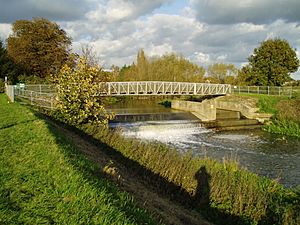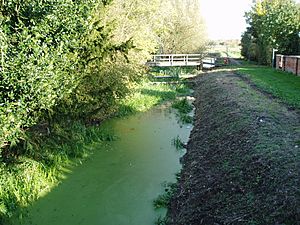Horncastle Canal facts for kids
Quick facts for kids Horncastle Canal |
|
|---|---|
| Specifications | |
| Maximum boat length | 72 ft 0 in (21.95 m) |
| Maximum boat beam | 15 ft 0 in (4.57 m) |
| Locks | 12 |
| Status | Reverted to river |
| History | |
| Original owner | Horncastle Canal Company |
| Principal engineer | William Jessop |
| Other engineer(s) | John Rennie |
| Date of act | 1792, 1800 |
| Date of first use | 1795 |
| Date completed | 1802 |
| Date closed | 1889 |
| Geography | |
| Start point | Horncastle |
| End point | River Witham, Dogdyke |
The Horncastle Canal was a waterway in Lincolnshire, England. It was 11 miles (about 18 kilometers) long. The canal connected the town of Horncastle to the River Witham. It used twelve locks and mostly followed the path of the River Bain. The canal opened in 1802. It was no longer used for boats after 1889.
Contents
History of the Horncastle Canal
In the 1790s, a very important local person named Sir Joseph Banks became interested in improving farming and trade. He had big plans for the area around Horncastle. One of his ideas was to build a canal. This canal would connect Horncastle to the River Witham.
Sir Joseph Banks gathered support from local business owners. He also spoke to landowners along the river. They formed a group to plan the canal. A special law, called an Act of Parliament, was needed to build it. This law was passed on June 11, 1792.
The new law also helped a shorter canal, called Gibson's Cut. This cut had been built earlier without official permission. The new company bought Gibson's Cut for £840.
Building the Canal
The company was allowed to raise money by selling shares. They hoped to get £15,000. If needed, they could raise another £10,000. Many people from the local area bought shares.
A famous engineer named William Jessop looked at the plans. He suggested two possible routes. The company chose the route that followed the River Bain to Tattershall. It then joined the River Witham at Dogdyke.
Jessop wanted the locks to be a certain size. But the company decided to make them bigger. This was so that larger boats already using the River Witham could also use the new canal.
Work on the canal began in April 1793. However, the quality of the work was not always good. One lock at Tattershall collapsed when it was first filled with water. The first engineer was fired. Several other engineers were hired but did not stay long.
Sections of the canal opened as they were finished. By 1795, the company was collecting tolls from boats. But they were running out of money. All the money they had raised was spent by 1797.
Another famous engineer, John Rennie, was asked for advice. He suggested building a new, straighter path for the canal. This new path would go from Dalderby to Horncastle.
A new Act of Parliament was passed in 1800. It allowed the company to raise another £20,000. But it was hard to find new investors. So, Lord Fortescue and Sir Joseph Banks lent the company £20,600. This money was paid back from the canal's future tolls.
The canal finally opened completely in 1802. It had cost almost four times more than first expected.
How the Canal Worked
The official opening of the canal was a big celebration. It happened on September 17, 1802. Horncastle declared it a public holiday. Boats were decorated with flags. A band played music. The workers were given free food and drinks.
The water level in the canal was controlled by a special gate called a sluice. This sluice was near where the River Bain met the River Waring. A person called a Staunchkeeper lived in a cottage next to the sluice. Their job was to adjust the sluice. This was very important during dry spells or floods.
For the first ten years, the money collected from tolls was used to pay back the loans. The company did not pay its first profit to shareholders until 1813. After that, profits slowly grew.
In the early 1850s, the canal was very busy. It carried about 9,710 tons of coal to Horncastle. It also carried about 5,420 tons of other goods. These goods included things like corn and wool.
The Canal's Decline
In 1848, a railway line opened from Lincoln to Boston. Then, in 1854, a new railway branch line opened. This line went from Kirkstead directly to Horncastle. This railway was a direct competitor to the canal.
After the railway opened, the canal quickly lost business. The last profit was paid to shareholders in 1873.
In 1888, it was suggested that the canal should be closed. The company sold some of its property to pay off debts. The canal was officially closed on September 23, 1889.
However, some parts of the canal were still used for a while. Sand and gravel were carried from Kirkby on Bain for another ten years. The lower parts of the canal were used until 1910. Boats carried coal from Goole to a wharf in Coningsby.
Plans for Restoration
There have been several ideas to bring the Horncastle Canal back to life. In 1975, a group called the Inland Waterways Association suggested restoring it. They thought more pleasure boats would need to use the River Witham first.
In 1986, they made a more detailed report. Since 1989, a group called the Horncastle and Tattershall Conningsby Canal Heritage group (HATCH) has been working on plans. They presented their ideas in 2003. The meeting agreed to raise money for a proper study. Now, the local government also supports the idea of restoring the canal.
|



